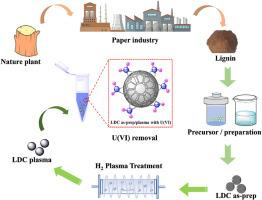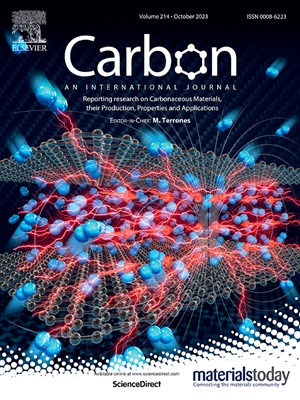Controlling synthesis of defect state lignin-derived carbon and application for U(VI) removal from aqueous solution: Effects of oxygen-defect and grain-size
IF 10.5
2区 材料科学
Q1 CHEMISTRY, PHYSICAL
引用次数: 0
Abstract
Lignin has deemed to be the main polluting component of paper industry wastewater. But developing a potential strategy for utilization of lignin is a challenges problem. Lignin derived materials present potential performance for heavy metal wastewater treatment due to their unique physicochemical properties, and were found to be promising candidate materials in U(VI) removal. However, it is still lacking of a comprehensive understanding that the influences of surface oxygen-defect and grain-size on U(VI) removal processes. Here, using lignin as the raw material, combining plasma treatment technology to prepare defect states Lignin Derived Carbon (LDC), and exploring the influences of surface oxygen-defect and grain-size on their removal U(VI) process. The results indicated that with the reducing of LDC particle size (from ∼4 to ∼ 1 μm), the removal performance of U(VI) was improved. And the U(VI) removal performance of LDC was further improved by introducing of oxygen defect via H2 plasma etch. The characterization analysis of defect states LDC before and after reaction with U(VI) shown that the U(VI) removal mechanism was dominated by defects site complexation. These finding provide deep insight into the recycling of industrial solid wastes lignin and improving of U(VI) removal performance via defect controlling technology.

控制缺陷态木质素衍生碳的合成并将其用于去除水溶液中的六(U):氧缺陷和晶粒尺寸的影响
木质素被认为是造纸工业废水的主要污染成分。但是,开发利用木质素的潜在策略却是一个难题。木质素衍生材料因其独特的物理化学特性而具有处理重金属废水的潜在性能,并被认为是去除 U(VI)的理想候选材料。然而,人们对表面氧缺陷和晶粒大小对去除 U(VI)过程的影响还缺乏全面的了解。本文以木质素为原料,结合等离子体处理技术制备了缺陷态木质素衍生碳(LDC),并探讨了表面氧缺陷和晶粒尺寸对其脱六氟化铀过程的影响。结果表明,随着 LDC 粒径的减小(从 ∼4 μm 减小到 ∼ 1 μm),U(VI)的去除性能得到改善。通过 H2 等离子刻蚀引入氧缺陷,进一步提高了 LDC 对 U(VI)的去除性能。对 LDC 与 U(VI) 反应前后缺陷状态的表征分析表明,U(VI) 的去除机理以缺陷位点复合为主。这些发现为工业固体废弃物木质素的回收利用以及通过缺陷控制技术提高六价铬去除性能提供了深刻的见解。
本文章由计算机程序翻译,如有差异,请以英文原文为准。
求助全文
约1分钟内获得全文
求助全文
来源期刊

Carbon
工程技术-材料科学:综合
CiteScore
20.80
自引率
7.30%
发文量
0
审稿时长
23 days
期刊介绍:
The journal Carbon is an international multidisciplinary forum for communicating scientific advances in the field of carbon materials. It reports new findings related to the formation, structure, properties, behaviors, and technological applications of carbons. Carbons are a broad class of ordered or disordered solid phases composed primarily of elemental carbon, including but not limited to carbon black, carbon fibers and filaments, carbon nanotubes, diamond and diamond-like carbon, fullerenes, glassy carbon, graphite, graphene, graphene-oxide, porous carbons, pyrolytic carbon, and other sp2 and non-sp2 hybridized carbon systems. Carbon is the companion title to the open access journal Carbon Trends. Relevant application areas for carbon materials include biology and medicine, catalysis, electronic, optoelectronic, spintronic, high-frequency, and photonic devices, energy storage and conversion systems, environmental applications and water treatment, smart materials and systems, and structural and thermal applications.
 求助内容:
求助内容: 应助结果提醒方式:
应助结果提醒方式:


